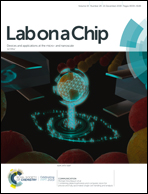Fabrication and verification of a glass–silicon–glass micro-/nanofluidic model for investigating multi-phase flow in shale-like unconventional dual-porosity tight porous media
Abstract
Unconventional shale or tight oil/gas reservoirs that have micro-/nano-sized dual-scale matrix pore throats with micro-fractures may result in different fluid flow mechanisms compared with conventional oil/gas reservoirs. Microfluidic models, as a potential powerful tool, have been used for decades for investigating fluid flow at the pore-scale in the energy field. However, almost all microfluidic models were fabricated by using etching methods and very few had dual-scale micro-/nanofluidic channels. Herein, we developed a lab-based, quick-processing and cost-effective fabrication method using a lift-off process combined with the anodic bonding method, which avoids the use of any etching methods. A dual-porosity matrix/micro-fracture pattern, which can mimic the topology of shale with random irregular grain shapes, was designed with the Voronoi algorithm. The pore channel width range is 3 μm to 10 μm for matrices and 100–200 μm for micro-fractures. Silicon is used as the material evaporated and deposited onto a glass wafer and then bonded with another glass wafer. The channel depth is the same (250 nm) as the deposited silicon thickness. By using an advanced confocal laser scanning microscopy (CLSM) system, we directly visualized the pore level flow within micro/nano dual-scale channels with fluorescent-dyed water and oil phases. We found a serious fingering phenomenon when water displaced oil in the conduits even if water has higher viscosity and the residual oil was distributed as different forms in the matrices, micro-fractures and conduits. We demonstrated that different matrix/micro-fracture/macro-fracture geometries would cause different flow patterns that affect the oil recovery consequently. Taking advantage of such a micro/nano dual-scale ‘shale-like’ microfluidic model fabricated by a much simpler and lower-cost method, studies on complex fluid flow behavior within shale or other tight heterogeneous porous media would be significantly beneficial.



 Please wait while we load your content...
Please wait while we load your content...
